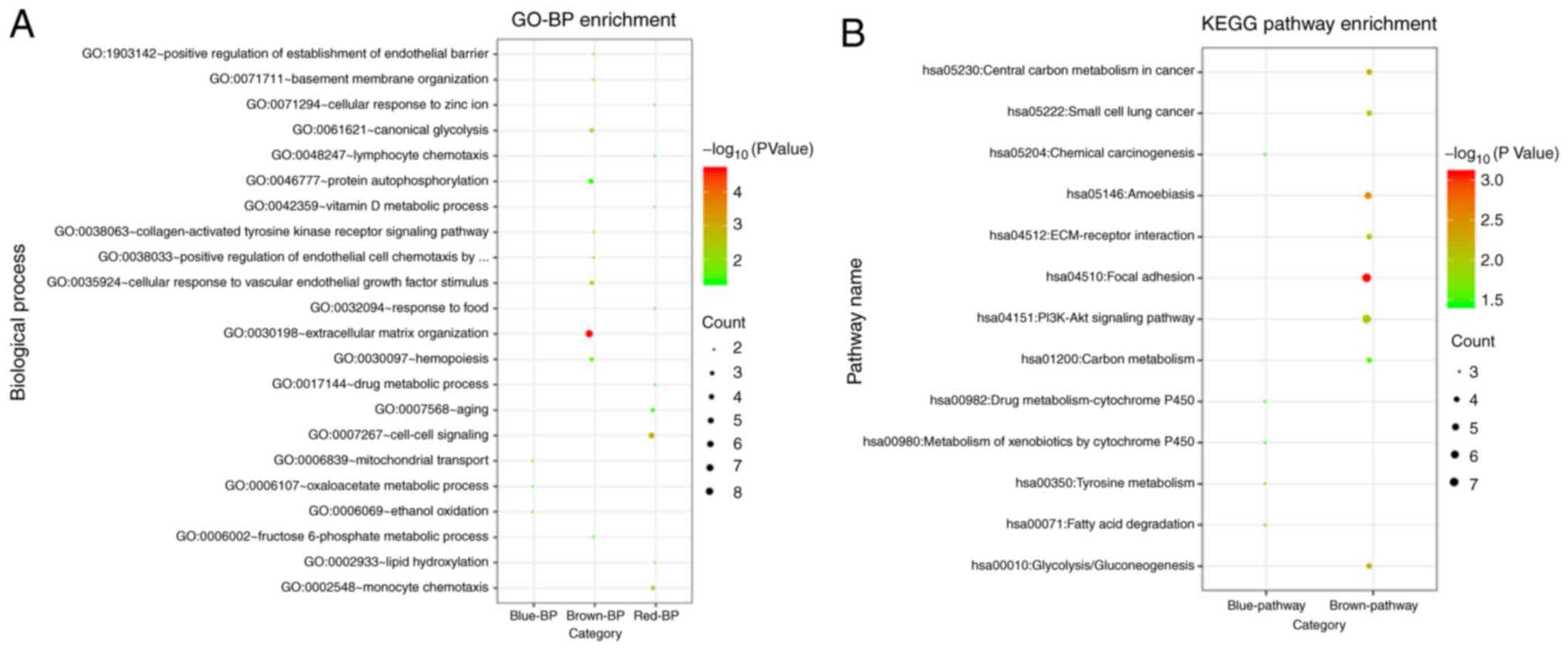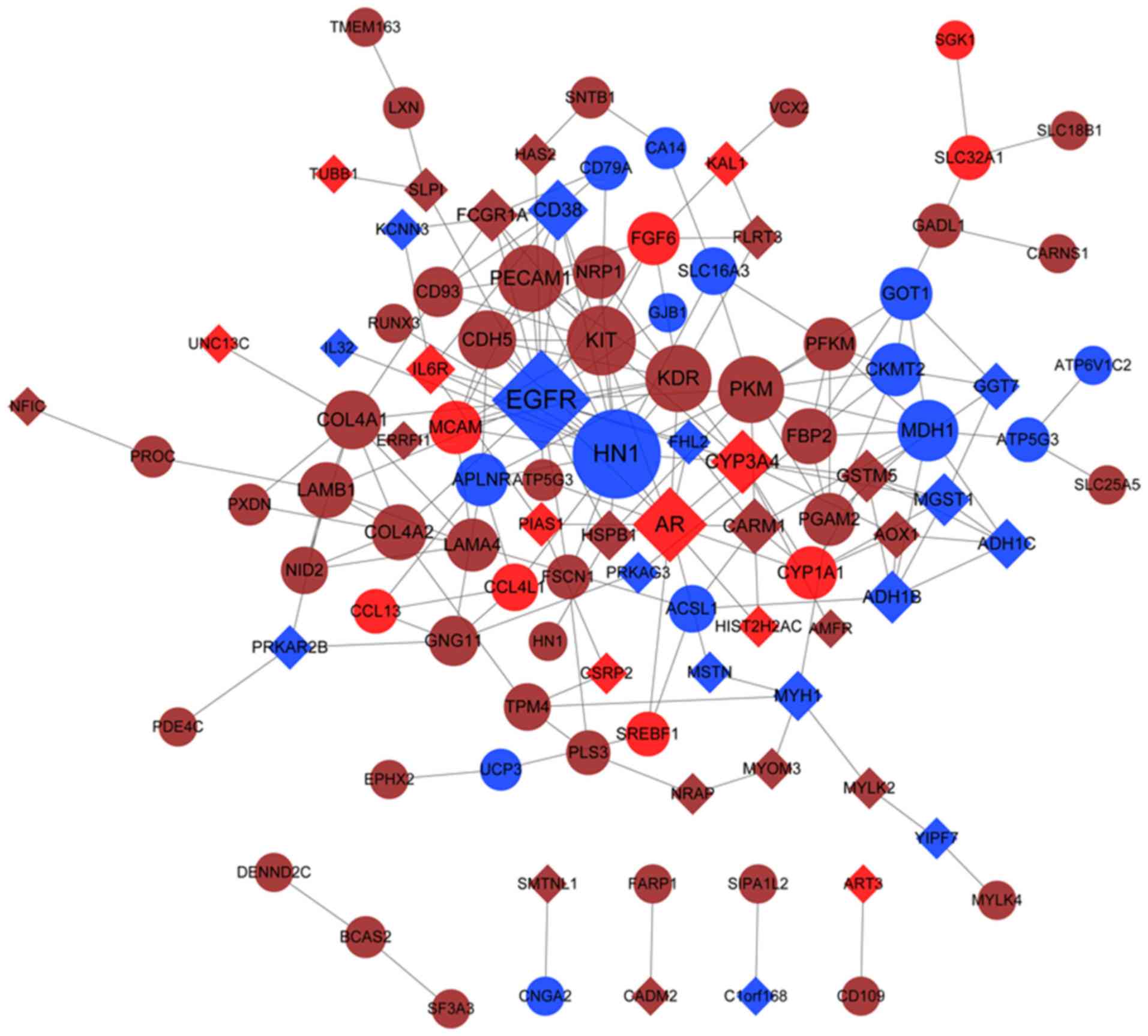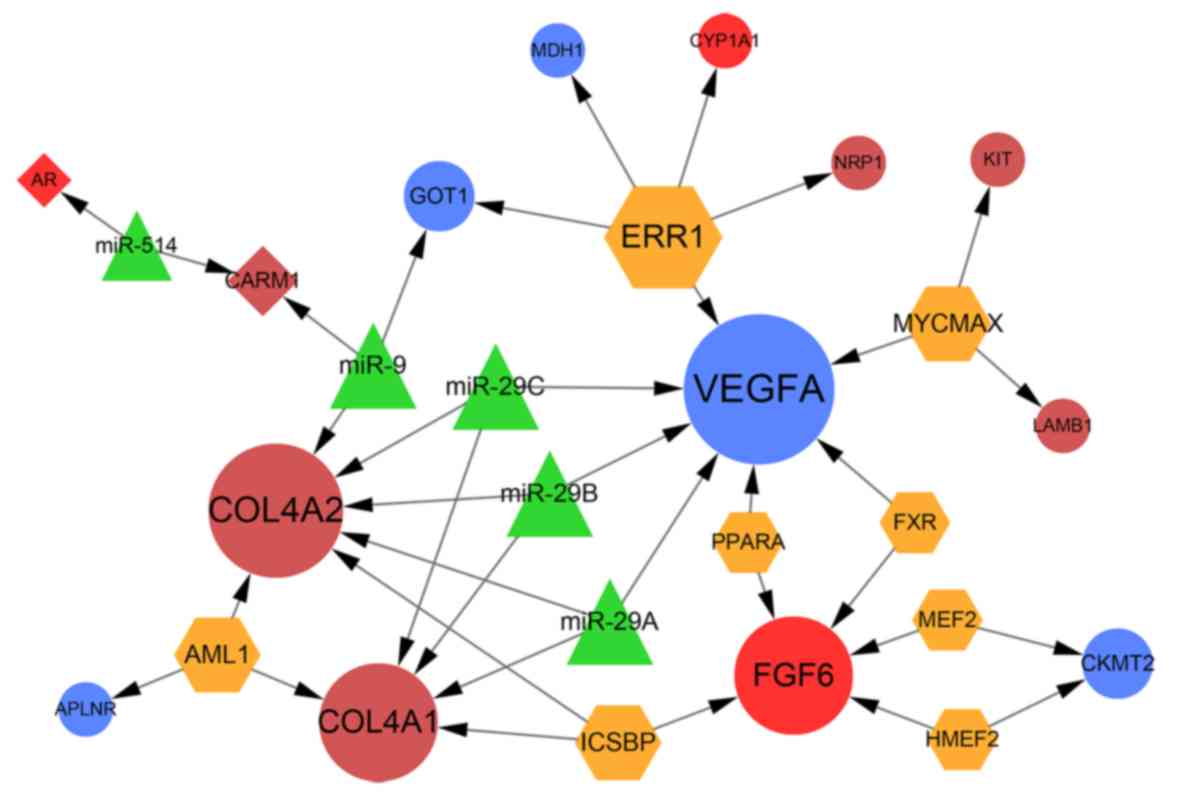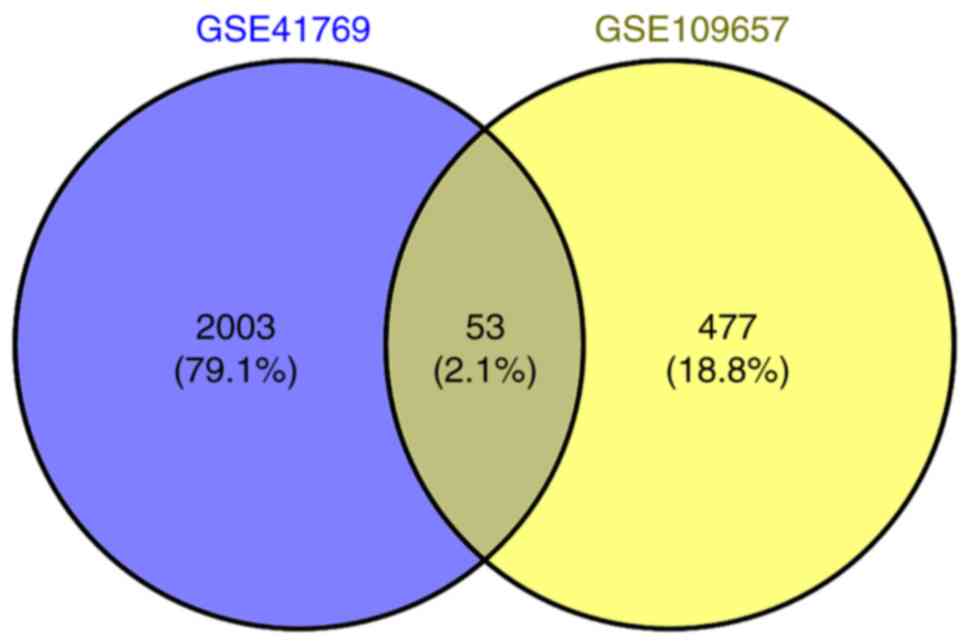|
1
|
Horak M, Novak J and Bienertova-Vasku J:
Muscle-specific microRNAs in skeletal muscle development. Dev Biol.
410:1–13. 2016. View Article : Google Scholar : PubMed/NCBI
|
|
2
|
Egan B and Zierath JR: Exercise metabolism
and the molecular regulation of skeletal muscle adaptation. Cell
Metab. 17:162–184. 2013. View Article : Google Scholar : PubMed/NCBI
|
|
3
|
Drake JC, Wilson RJ and Yan Z: Molecular
mechanisms for mitochondrial adaptation to exercise training in
skeletal muscle. FASEB J. 30:13–22. 2016. View Article : Google Scholar : PubMed/NCBI
|
|
4
|
Tunstall RJ, Mehan KA, Wadley GD, Collier
GR, Bonen A, Hargreaves M and Cameron-Smith D: Exercise training
increases lipid metabolism gene expression in human skeletal
muscle. Am J Physiol Endocrinol Metab. 283:E66–E72. 2002.
View Article : Google Scholar : PubMed/NCBI
|
|
5
|
Nieman DC, Shanely RA, Zwetsloot KA,
Meaney MP and Farris GE: Ultrasonic assessment of exercise-induced
change in skeletal muscle glycogen content. BMC Sports Sci Med
Rehabil. 7:92015. View Article : Google Scholar : PubMed/NCBI
|
|
6
|
Hoppeler H: Exercise-induced
ultrastructural changes in skeletal muscle. Int J Sports Med.
7:187–204. 1986. View Article : Google Scholar : PubMed/NCBI
|
|
7
|
Baar K, Wende AR, Jones TE, Marison M,
Nolte LA, Chen M, Kelly DP and Holloszy JO: Adaptations of skeletal
muscle to exercise: Rapid increase in the transcriptional
coactivator PGC-1. FASEB J. 16:1879–1886. 2002. View Article : Google Scholar : PubMed/NCBI
|
|
8
|
Cantó C, Jiang LQ, Deshmukh AS, Mataki C,
Coste A, Lagouge M, Zierath JR and Auwerx J: Interdependence of
AMPK and SIRT1 for metabolic adaptation to fasting and exercise in
skeletal muscle. Cell Metab. 11:213–219. 2010. View Article : Google Scholar : PubMed/NCBI
|
|
9
|
Tzanis G, Philippou A, Karatzanos E,
Dimopoulos S, Kaldara E, Nana E, Pitsolis T, Rontogianni D,
Koutsilieris M and Nanas S: Effects of high-intensity interval
exercise training on skeletal myopathy of chronic heart failure. J
Card Fail. 23:36–46. 2017. View Article : Google Scholar : PubMed/NCBI
|
|
10
|
Peake JM, Della Gatta P, Suzuki K and
Nieman DC: Cytokine expression and secretion by skeletal muscle
cells: Regulatory mechanisms and exercise effects. Exerc Immunol
Rev. 21:8–25. 2015.PubMed/NCBI
|
|
11
|
McCarthy JJ: microRNA and skeletal muscle
function: Novel potential roles in exercise, diseases, and aging.
Front Physiol. 5:290. 2014. View Article : Google Scholar : PubMed/NCBI
|
|
12
|
Xu Y, Zhao C, Sun X, Liu Z and Zhang J:
MicroRNA-761 regulates mitochondrial biogenesis in mouse skeletal
muscle in response to exercise. Biochem Biophys Res Commun.
467:103–108. 2015. View Article : Google Scholar : PubMed/NCBI
|
|
13
|
Sasaki T, Kuboyama A, Mita M, Murata S,
Shimizu M, Inoue J, Mori K and Sato R: The exercise-inducible bile
acid receptor Tgr5 improves skeletal muscle function in mice. J
Biol Chem. 293:10322–10332. 2018. View Article : Google Scholar : PubMed/NCBI
|
|
14
|
Henríquez-Olguín C, Renani LB,
Arab-Ceschia L, Raun SH, Bhatia A, Li Z, Knudsen JR, Holmdahl R and
Jensen TE: Adaptations to high-intensity interval training in
skeletal muscle require NADPH oxidase 2. Redox Biol. 24:1011882019.
View Article : Google Scholar : PubMed/NCBI
|
|
15
|
Miyamoto-Mikami E, Tsuji K, Horii N,
Hasegawa N, Fujie S, Homma T, Uchida M, Hamaoka T, Kanehisa H,
Tabata I, et al: Gene expression profile of muscle adaptation to
high-intensity intermittent exercise training in young men. Sci
Rep. 8:16811. 2018. View Article : Google Scholar : PubMed/NCBI
|
|
16
|
Song WM and Zhang B: Multiscale embedded
gene co-expression network analysis. PLOS Comput Biol.
11:e10045742015. View Article : Google Scholar : PubMed/NCBI
|
|
17
|
Ritchie ME, Phipson B, Wu D, Hu Y, Law CW,
Shi W and Smyth GK: limma powers differential expression analyses
for RNA-sequencing and microarray studies. Nucleic Acids Res.
43:e472015. View Article : Google Scholar : PubMed/NCBI
|
|
18
|
Langfelder P and Horvath S: WGCNA: An R
package for weighted correlation network analysis. BMC
Bioinformatics. 9:5592008. View Article : Google Scholar : PubMed/NCBI
|
|
19
|
Ni M, Liu X, Wu J, Zhang D, Tian J, Wang
T, Liu S, Meng Z, Wang K, Duan X, et al: Identification of
candidate biomarkers correlated with the pathogenesis and prognosis
of non-small cell lung cancer via integrated bioinformatics
analysis. Front Genet. 9:4692018. View Article : Google Scholar : PubMed/NCBI
|
|
20
|
Catoire M, Mensink M, Boekschoten MV,
Hangelbroek R, Müller M, Schrauwen P and Kersten S: Pronounced
effects of acute endurance exercise on gene expression in resting
and exercising human skeletal muscle. PLoS One. 7:e510662012.
View Article : Google Scholar : PubMed/NCBI
|
|
21
|
Teng ACT, Kuraitis D, Deeke SA, Ahmadi A,
Dugan SG, Cheng BLM, Crowson MG, Burgon PG, Suuronen EJ, Chen HH,
et al: IRF2BP2 is a skeletal and cardiac muscle-enriched
ischemia-inducible activator of VEGFA expression. FASEB J.
24:4825–4834. 2010. View Article : Google Scholar : PubMed/NCBI
|
|
22
|
Gustafsson T, Rundqvist H, Norrbom J,
Rullman E, Jansson E and Sundberg CJ: The influence of physical
training on the angiopoietin and VEGF-A systems in human skeletal
muscle. J Appl Physiol 1985. 103:1012–1020. 2007. View Article : Google Scholar : PubMed/NCBI
|
|
23
|
Baum O, Gübeli J, Frese S, Torchetti E,
Malik C, Odriozola A, Graber F, Hoppeler H and Tschanz SA:
Angiogenesis-related ultrastructural changes to capillaries in
human skeletal muscle in response to endurance exercise. J Appl
Physiol 1985. 119:1118–1126. 2015. View Article : Google Scholar : PubMed/NCBI
|
|
24
|
Haas TL and Nwadozi E: Regulation of
skeletal muscle capillary growth in exercise and disease. Appl
Physiol Nutr Metab. 40:1221–1232. 2015. View Article : Google Scholar : PubMed/NCBI
|
|
25
|
Morland C, Andersson KA, Haugen ØP, Hadzic
A, Kleppa L, Gille A, Rinholm JE, Palibrk V, Diget EH, Kennedy LH,
et al: Exercise induces cerebral VEGF and angiogenesis via the
lactate receptor HCAR1. Nat Commun. 8:155572017. View Article : Google Scholar : PubMed/NCBI
|
|
26
|
Palazon A, Tyrakis PA, Macias D, Veliça P,
Rundqvist H, Fitzpatrick S, Vojnovic N, Phan AT, Loman N, Hedenfalk
I, et al: An HIF-1α/VEGF-A axis in cytotoxic T cells regulates
tumor progression. Cancer Cell. 32:669–683.e5. 2017. View Article : Google Scholar : PubMed/NCBI
|
|
27
|
Karvinen H, Pasanen E, Rissanen TT,
Korpisalo P, Vähäkangas E, Jazwa A, Giacca M and Ylä-Herttuala S:
Long-term VEGF-A expression promotes aberrant angiogenesis and
fibrosis in skeletal muscle. Gene Ther. 18:1166–1172. 2011.
View Article : Google Scholar : PubMed/NCBI
|
|
28
|
Klagsbrun M: Regulators of angiogenesis:
Stimulators, inhibitors, and extracellular matrix. J Cell Biochem.
47:199–200. 1991. View Article : Google Scholar : PubMed/NCBI
|
|
29
|
Sottile J: Regulation of angiogenesis by
extracellular matrix. BBA-Reviews on Cancer. 1654:13–22.
2004.PubMed/NCBI
|
|
30
|
Zhao X and Guan JL: Focal adhesion kinase
and its signaling pathways in cell migration and angiogenesis. Adv
Drug Deliv Rev. 63:610–615. 2011. View Article : Google Scholar : PubMed/NCBI
|
|
31
|
Wary KK, Kohler EE and Chatterjee I: Focal
adhesion kinase regulation of neovascularization. Microvasc Res.
83:64–70. 2012. View Article : Google Scholar : PubMed/NCBI
|
|
32
|
Tsuji-Tamura K and Ogawa M: Inhibition of
the PI3K-Akt and mTORC1 signaling pathways promotes the elongation
of vascular endothelial cells. J Cell Sci. 129:1165–1178. 2016.
View Article : Google Scholar : PubMed/NCBI
|
|
33
|
Lee NY, Golzio C, Gatza CE, Sharma A,
Katsanis N and Blobe GC: Endoglin regulates PI3-kinase/Akt
trafficking and signaling to alter endothelial capillary stability
during angiogenesis. Mol Biol Cell. 23:2412–2423. 2012. View Article : Google Scholar : PubMed/NCBI
|
|
34
|
Mao M, Alavi MV, Labelle-Dumais C, Gould
DB and Type IV: Type IV collagens and basement membrane diseases:
Cell biology and pathogenic mechanisms. Curr Top Membr. 76:61–116.
2015. View Article : Google Scholar : PubMed/NCBI
|
|
35
|
Guiraud S, Migeon T, Ferry A, Chen Z,
Ouchelouche S, Verpont MC, Sado Y, Allamand V, Ronco P and Plaisier
E: HANAC Col4a1 mutation in mice leads to skeletal muscle
alterations due to a primary vascular defect. Am J Pathol.
187:505–516. 2017. View Article : Google Scholar : PubMed/NCBI
|
|
36
|
Wei W, He HB, Zhang WY, Zhang HX, Bai JB,
Liu HZ, Cao JH, Chang KC, Li XY and Zhao SH: miR-29 targets Akt3 to
reduce proliferation and facilitate differentiation of myoblasts in
skeletal muscle development. Cell Death Dis. 4:e6682013. View Article : Google Scholar : PubMed/NCBI
|
|
37
|
Li N, Cui J, Duan X, Chen H and Fan F:
Suppression of type I collagen expression by miR-29b via PI3K, Akt,
and Sp1 pathway in human Tenon's fibroblasts. Invest Ophthalmol Vis
Sci. 53:1670–1678. 2012. View Article : Google Scholar : PubMed/NCBI
|
|
38
|
Chen HX, Xu XX, Tan BZ, Zhang Z and Zhou
XD: MicroRNA-29b inhibits angiogenesis by targeting VEGFA through
the MAPK/ERK and PI3K/Akt signaling pathways in endometrial
carcinoma. Cell Physiol Biochem. 41:933–946. 2017. View Article : Google Scholar : PubMed/NCBI
|
|
39
|
Hu Y, Deng F, Song J, Lin J, Li X, Tang Y,
Zhou J, Tang T and Zheng L: Evaluation of miR-29c inhibits
endotheliocyte migration and angiogenesis of human endothelial
cells by suppressing the insulin like growth factor 1. Am J Transl
Res. 7:489–501. 2015.PubMed/NCBI
|
|
40
|
Yang Z, Wu L, Zhu X, Xu J, Jin R, Li G and
Wu F: MiR-29a modulates the angiogenic properties of human
endothelial cells. Biochem Biophys Res Commun. 434:143–149. 2013.
View Article : Google Scholar : PubMed/NCBI
|
















